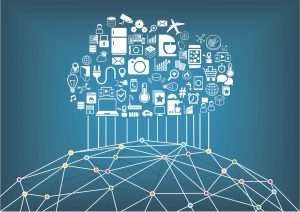With the coming of 5G IoT radio network services, we are embarking on an overhaul of the global communications infrastructure — effectively replacing one wireless architecture created this century, with another one that aims to lower energy consumption and maintenance costs.
The principal stakeholders of 5G wireless technology — telecommunications providers, transmission equipment makers, antenna manufacturers, and server manufacturers — are all looking to deliver on the promise that, once all of 5G’s components are fully deployed and operational, cables and wires will become a thing of the past, when it comes to delivering communications, entertainment, network connectivity, and a host of other services.
In this article, we’ll be looking at how close they are to making good on this promise, by examining some of the existing and proposed use cases for 5G IoT radio network services.
What Is 5G?
5G is the fifth generation of mobile network technology. Each generation has its own defining characteristics such as frequency bands, advances in transmission technology, and bit rates.
The first generation or 1G was introduced in 1982. It was never an official standard, though several attempts were made to standardise digital wireless cellular transmission, none of which became global. 2G / GSM launched in around 1992, at the same time as much of the world was adopting CDMA. The global standards community finally came together with their 3rd Generation Partnership Project (3GPP), and 3G appeared in the early 2000s. 4G was standardised in 2012.
At maximum performance, 4G networks have a theoretical download speed of 1 gigabyte per second. 5G networks start at 10 gigabytes per second, with a theoretical maximum of 20 gigabytes per second or beyond. 5G also offers lower latency or network lag, which essentially means less time for information to travel through the system.
In addition to raw speed and stability, 5G offers a form of segmentation known as network slicing. This allows for multiple virtual networks to be created on top of a shared physical infrastructure. It also provides the ability to span across multiple parts of a network, such as the core network, transport layer, or access network. Each network slice can create an end to end virtual network, with both compute and storage functionality.
What Are 5G IoT Radio Network Services?
Internet of Things or IoT devices and platforms use a variety of wireless technologies, including short-range technology of the unlicensed spectrum, such as Wi-Fi, Bluetooth, or ZigBee, and technologies from the licensed spectrum, such as GSM and LTE. The licensed technologies offer a number of benefits for IoT devices, including enhanced provisioning, device management, and service enablement.
The emerging licensed technology of 5G IoT radio network services provide a range of opportunities to the IoT which are not available with 4G or other technologies. These include the ability to support a massive number of static or mobile IoT devices, which have a diverse range of speed, bandwidth, and quality of service requirements.
Much of the global 5G plan involves multiple, simultaneous antennas, some of which use a spectrum that telecommunications providers agree to share with each other. Other parts of the deployment will include portions of the unlicensed spectrum that telecommunications regulators will keep open for everyone at all times. For this reason, some of the 5G technologies include systems that will enable transmitters and receivers to arbitrate access to unused channels in the unlicensed spectrum.
Most of these 5G IoT radio network services can be grouped under three main categories: enhanced mobile broadband (eMBB), massive IoT (also known as massive Machine Type Communications or mMTC), and critical communications.
Enhanced Mobile Broadband (eMBB)
Enhanced mobile broadband (eMBB) under 5G will have the capacity to support large volumes of data traffic and large numbers of users, including IoT devices. Some estimates put this capacity at a minimum of 100GB per month per customer, greatly expanding the consumer IoT market by delivering high-speed, low-latency, reliable, and secure connections. In addition, the cost of data transmission per bit is set to decrease, making the prospect of “unlimited” data bundles finally feasible.
Enhanced mobile broadband will support the delivery of high definition video at the consumer level (e.g., for TV and gaming), and immersive communications, such as video calls and augmented reality and virtual reality (AR and VR). Some predictions for 5G latency put it as low as 1 millisecond between a device and its base station, increasing the prospects for fingertip control over remote assets (the so-called “tactile internet”), and high definition video conferencing. It will also facilitate data transfer for smart city services, including IoT video cameras for surveillance.
eMBB is intended to service more densely populated metropolitan areas with download speeds approaching 1 Gbps (gigabit per second) indoors, and 300 Mbps (megabits per second) outdoors. This will require the installation of extremely high-frequency millimetre-wave (mmWave) antennas throughout the landscape, potentially numbering in the hundreds or even thousands.
For more rural and suburban areas, enhanced mobile broadband is looking to replace the 4G LTE system, with a new network of lower-power omnidirectional antennas that provide a 50 Mbps download service.
Massive IoT (mMTC)
Massive Machine Type Communications or mMTC allow machine-to-machine (M2M) and internet of Things (IoT) applications to operate without imposing burdens on other classes of service. 3GPP narrowband IoT (NB-IoT) and Long-Term Evolution Machine Type Communications (LTE-M) are existing technologies which are integral to the new breed of 5G era fast broadband communications.
These 4G technologies are expected to continue under full support in 5G networks for the foreseeable future. They are currently providing mobile IoT solutions for smart cities, smart logistics, and smart metering. As 5G evolves, they will be used to access multimedia content, stream augmented reality and 3D video, and to cater for critical communications like factory automation, and smart power grids.
mMTC maintains service levels by implementing a compartmentalised service tier for devices that require a download bandwidth as low as 100 Kbps, but with latency that’s kept low at around 10 milliseconds.
Critical Communications
For critical communications requirements where bandwidth matters less than speed, Ultra Reliable and Low Latency Communications (URLLC) technology can provide an end-to-end latency of 1 millisecond or less. This level of service would enable autonomous or self-driving vehicles, where decision and reaction times have to be near instantaneous. For enterprises, the extreme reliability and low latency of 5G will allow for smart energy grids, enhanced factory automation, and other demanding applications with rigorous requirements.
URLLC actually has the potential to make 5G competitive with satellite, which opens up the possibility of using 5G IoT radio network services as an alternative to GPS for geographical location.
A supplementary set of 5G standards called “Release 16” that was scheduled for the end of 2019 includes specifications for Vehicle-to-Everything (V2X) communications. This technology incorporates low-latency links between moving vehicles (especially those with autonomous driving systems) and cloud data centres. This enables much of the control and maintenance software for moving vehicles to operate from within static data centres, staffed by human personnel.
Use Cases For 5G IoT Radio Network Services
Industry analysts reckon that the initial costs of 5G infrastructure improvement could be astronomical. In order to cover themselves financially, telecommunications companies and other stakeholders in the ecosystem will need to offer new classes of service to new customer segments.
A number of use cases currently exist or are on the horizon.
Cloud And Edge Computing
The wireless technology of 5G IoT radio network services offers the potential for distributing cloud computing services much closer to users than most of the data centres operated by major players like Amazon, Google, or Microsoft. For critical, high-intensity workloads, this could make 5G service providers viable competitors as cloud providers.
Similarly, by bringing processing power closer to the consumer and minimising the latency caused by distance, 5G becomes a vehicle for edge computing environments, where data handling has to occur as close to devices and applications as possible. With latency reductions of a sufficient magnitude, applications that currently require desktop systems or laptops could be relocated to smaller and more mobile devices with significantly less on-board processing power.
Automotive Industry
The high bandwidth connectivity of 5G can provide a seamless and high quality of service for vehicle navigation, infotainment, and other services in standard and autonomous vehicles. Low latency and high bandwidth connections can support vehicle platoons, which improve fuel efficiency and reduce the number of drivers required on the road.
Near-zero latency is enabling the development of driverless or autonomous vehicle technology, while network slicing provides road and infrastructure managers with a greater degree of flexibility, and the option to allocate network slices to specific functions.
(Image source: GSMA)
While it’s unlikely that there will be mass adoption of fully autonomous vehicles on public roads for some years to come, connected and smart vehicles are becoming increasingly popular. For instance, 75% of cars shipped in 2020 in Australia are likely to be have some form of connectivity.
Media And Content Delivery
The high bandwidth and low latency of 5G enable the high volume transmission of high definition video in real time. This makes both video conferencing and streaming entertainment faster and more engaging for the participants. These activities also become more versatile, as 5G can support live broadcasting using smartphones, and interactive and immersive VR experiences.
5G Fixed Wireless Access (FWA) systems allow home broadband services to be set up quickly and cost-effectively in rural and other areas that don’t have access to fixed line home broadband. FWA can deliver speeds similar to fibre-based services, at a considerably lower cost (around 74%) than wired connections.
Coupled with edge computing, the low latency and high bandwidth of 5G can enhance the cloud gaming experience, with the edge processing of large volumes of data reducing the need for more powerful AR / VR headsets. Similar enhancements using augmented and virtual reality are enabling organisations in the retail sector to create memorable customer experiences.
Manufacturing
5G IoT radio network services allow the connection of large numbers of devices in a secure and cost-efficient manner, while low latency connectivity enables the virtual control of machines. Fewer processing units are therefore required on the factory floor, while telemetry or information exchange can occur between a large number of interconnected devices in real time.
As with the automotive industry, network slicing allows manufacturers to allocate network slices to specific functions, and a combination of cloud computing, eMBB, and mMTC can facilitate the transmission of real time information at high resolutions.
Health Care
Cables and wires in operating theatres could be replaced by the low latency and secure wireless connections made possible through 5G. For hospital administration, data analytics across medical records will have improved efficiency, while AR and VR delivered via low latency and high bandwidth 5G can aid in diagnosis, and the training of medical staff. Remote real-time diagnostics can also be enhanced by delivering high quality video over 5G.
In future, 5G IoT radio network services may even power robots for the dispensing of pharmaceuticals, support diagnostics, and performing certain types of surgery.
Smart Cities
5G IoT networks have the potential to aid in city management, for example, through the deployment of city-wide air quality monitors, and alert systems for health and safety hazards. The mass digitalisation of some public services is possible, and the use of connected vehicles for police and emergency services, linked to traffic lights.
Network slicing will allow city managers to provide higher security and reliability for mission-critical services.
Smart Utilities
Improved edge computing will enable utilities providers to better scale their number of connected devices, and deploy platforms and analytics capable of handling the increased data volumes in real-time.
5G wireless could provide a flexible and cost-effective alternative to last mile fibre, and assist the longer term management of complex virtual energy production plants.
Looking Ahead
While 5G wireless will do away with much of the cabling architecture of current cities, the platform’s requirements for short-range infrastructure — numerous small, low power base stations containing the transmitters and receivers — will create a new and characteristic form of landscape.
The 5G mobile cellular networks in use today are evolving from existing 4G networks, which will continue to serve many functions. Moving forward, 5G IoT radio network services providers will need to ensure that their networks support both current and future use case requirements.





